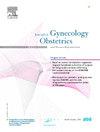Development and temporal validation of a deep learning model for automatic fetal biometry from ultrasound videos
IF 1.6
4区 医学
Q3 OBSTETRICS & GYNECOLOGY
Journal of gynecology obstetrics and human reproduction
Pub Date : 2025-09-22
DOI:10.1016/j.jogoh.2025.103039
引用次数: 0
Abstract
Objectives
The objective was to develop an artificial intelligence (AI)-based system, using deep neural network (DNN) technology, to automatically detect standard fetal planes during video capture, measure fetal biometry parameters and estimate fetal weight.
Methods
A standard plane recognition DNN was trained to classify ultrasound images into four categories: head circumference (HC), abdominal circumference (AC), femur length (FL) standard planes, or ‘other’. The recognized standard plane images were subsequently processed by three fetal biometry DNNs, automatically measuring HC, AC and FL. Fetal weight was then estimated with the Hadlock 3 formula. The training dataset consisted of 16,626 images. A prospective temporal validation was then conducted using an independent set of 281 ultrasound videos of healthy fetuses. Fetal weight and biometry measurements were compared against an expert sonographer. Two less experienced sonographers were used as controls.
Results
The AI system obtained a significantly lower absolute relative measurement error in fetal weight estimation than the controls (AI vs. medium-level: p = 0.032, AI vs. beginner: p < 1e-8), so in AC measurements (AI vs. medium-level: p = 1.72e-04, AI vs. beginner: p < 1e-06). Average absolute relative measurement errors of AI versus expert were: 0.96 % (S.D. 0.79 %) for HC, 1.56 % (S.D. 1.39 %) for AC, 1.77 % (S.D. 1.46 %) for FL and 3.10 % (S.D. 2.74 %) for fetal weight estimation.
Conclusion
The AI system produced similar biometry measurements and fetal weight estimation to those of the expert sonographer. It is a promising tool to enhance non-expert sonographers’ performance and reproducibility in fetal biometry measurements, and to reduce inter-operator variability.
基于超声视频的胎儿生物自动测量深度学习模型的开发与时间验证。
目的:开发一种基于人工智能(AI)的系统,利用深度神经网络(DNN)技术,在视频采集过程中自动检测标准胎儿平面,测量胎儿生物特征参数并估计胎儿体重。方法:训练标准平面识别深度神经网络,将超声图像分为头围(HC)、腹围(AC)、股骨长(FL)标准平面和“其他”四类。识别的标准平面图像随后由三个胎儿生物测量dnn进行处理,自动测量HC、AC和FL。然后使用Hadlock 3公式估计胎儿体重。训练数据集由16,626张图像组成。然后使用一组281健康胎儿的独立超声视频进行前瞻性时间验证。胎儿体重和生物测量值与专家超声检查进行比较。两名经验不足的超声技师作为对照。结果:AI系统在胎儿体重估计中获得的绝对相对测量误差明显低于对照组(AI与中等水平:p = 0.032,AI与初学者:p < 1e-8),因此在AC测量中(AI与中等水平:p = 1.72e-04, AI与初学者:p < 1e-06)。人工智能与专家的平均绝对相对测量误差为:HC为0.96% (sd = 0.79%), AC为1.56% (sd = 1.39%), FL为1.77% (sd = 1.46%),胎儿体重估计为3.10% (sd = 2.74%)。结论:人工智能系统产生的生物测量和胎儿体重估计与专家超声检查相似。它是一种很有前途的工具,可以提高非专业超声医师在胎儿生物测量中的表现和再现性,并减少操作员之间的差异。
本文章由计算机程序翻译,如有差异,请以英文原文为准。
求助全文
约1分钟内获得全文
求助全文
来源期刊

Journal of gynecology obstetrics and human reproduction
Medicine-Obstetrics and Gynecology
CiteScore
3.70
自引率
5.30%
发文量
210
审稿时长
31 days
期刊介绍:
Formerly known as Journal de Gynécologie Obstétrique et Biologie de la Reproduction, Journal of Gynecology Obstetrics and Human Reproduction is the official Academic publication of the French College of Obstetricians and Gynecologists (Collège National des Gynécologues et Obstétriciens Français / CNGOF).
J Gynecol Obstet Hum Reprod publishes monthly, in English, research papers and techniques in the fields of Gynecology, Obstetrics, Neonatology and Human Reproduction: (guest) editorials, original articles, reviews, updates, technical notes, case reports, letters to the editor and guidelines.
Original works include clinical or laboratory investigations and clinical or equipment reports. Reviews include narrative reviews, systematic reviews and meta-analyses.
 求助内容:
求助内容: 应助结果提醒方式:
应助结果提醒方式:


